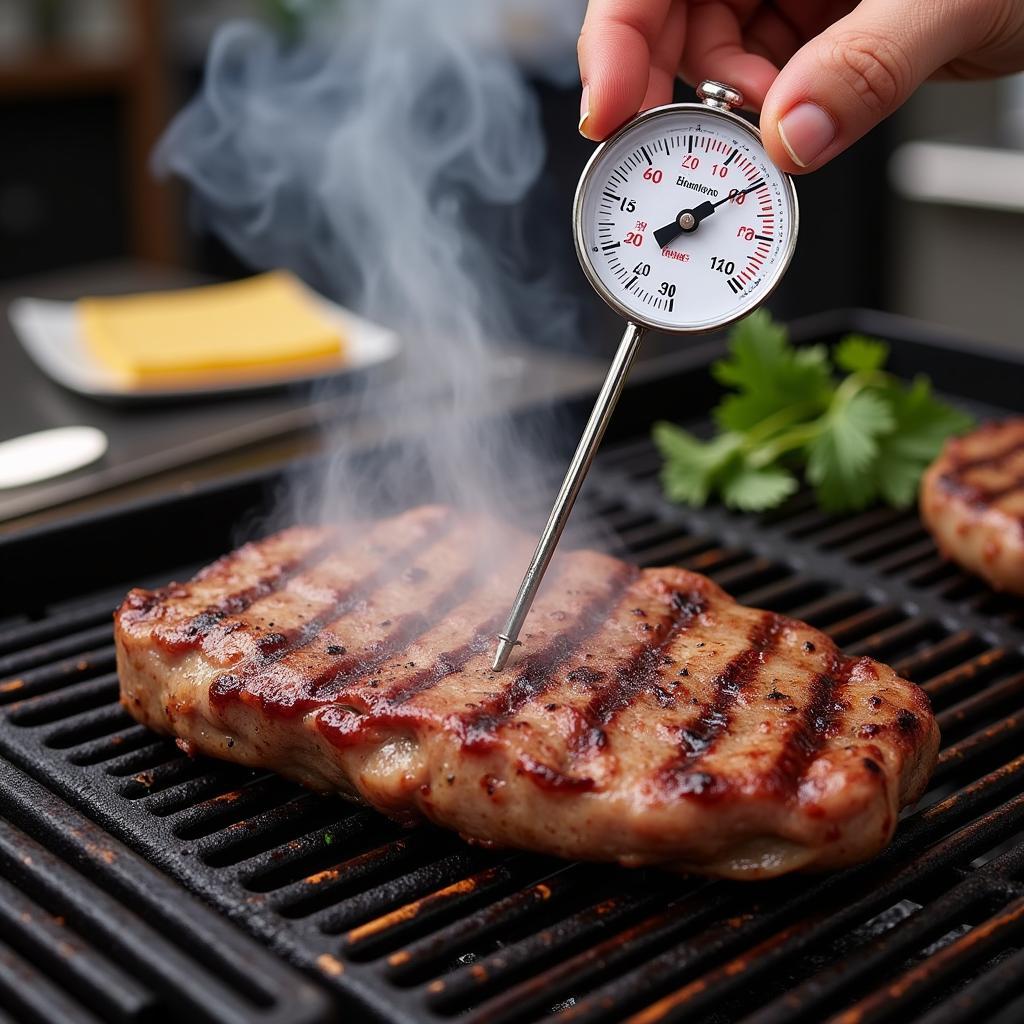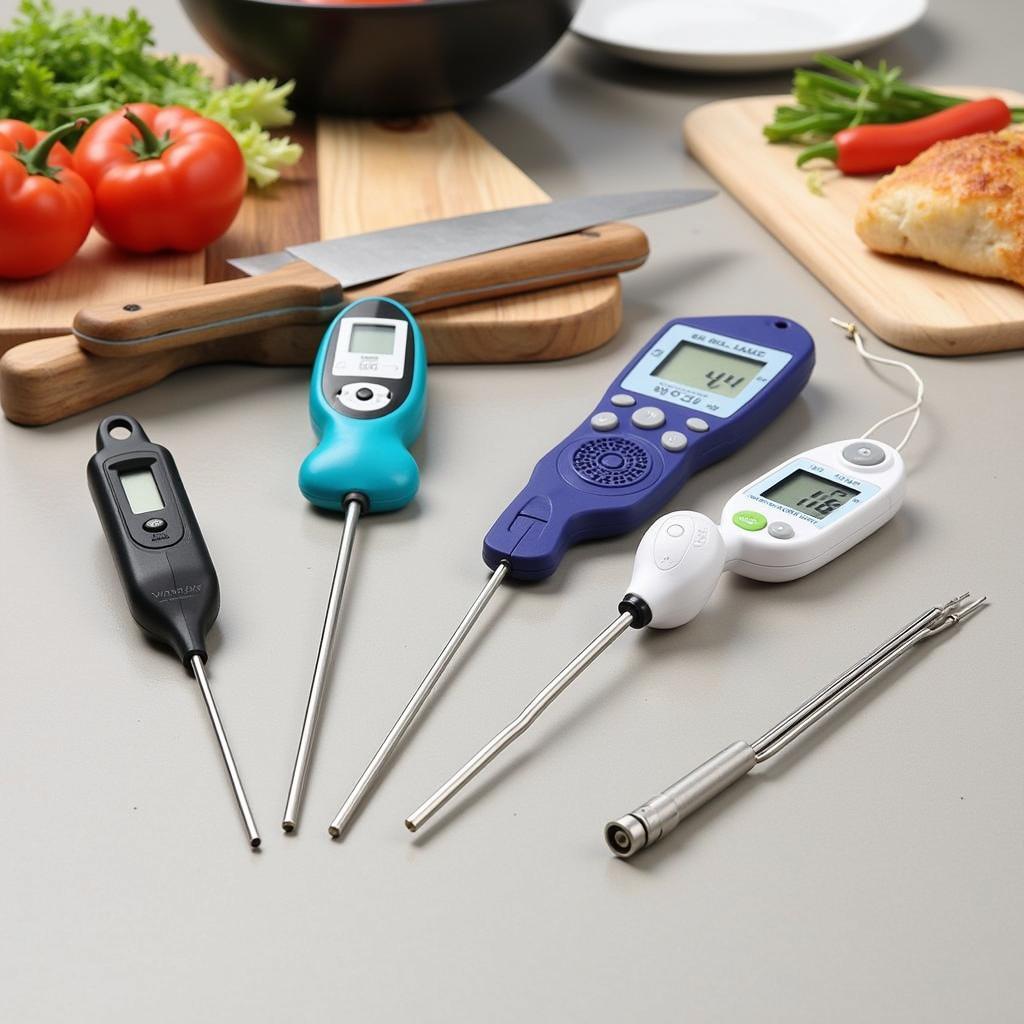Food Service Thermometers are essential tools for anyone working with food, whether you’re a professional chef or a home cook. They are your first line of defense against foodborne illnesses and guarantee perfectly cooked dishes every time. Let’s delve into why these handy devices are so crucial and how to use them effectively.
Ensuring food safety is paramount in any food service operation. Using food service thermometers accurately is the most reliable way to determine if food has reached a safe internal temperature, eliminating the guesswork and ensuring harmful bacteria are destroyed. Beyond safety, these tools contribute significantly to food quality. A perfectly cooked steak, a flaky fish fillet, or a moist chicken breast – all are achievable with the precise temperature control a food service thermometer provides. This detailed guide will explore the various types of food service thermometers, their proper usage, and maintenance, empowering you to confidently serve safe and delicious food. Check out this guide on getting your food handlers permit pa.
Types of Food Service Thermometers
Different culinary tasks require different thermometers. Here’s a breakdown of the most common types:
-
Bimetallic Stem Thermometers: These are the workhorses of the food service industry, reliable and affordable. They’re perfect for checking the temperature of thick or thin foods during cooking.
-
Digital Instant-Read Thermometers: Offering quick and accurate readings, these are ideal for spot-checking temperatures and are particularly useful for thin foods or liquids.
-
Thermocouples and Thermistors: These thermometers provide almost instantaneous readings, making them excellent for high-volume kitchens.
-
Infrared Thermometers: While convenient for surface temperature checks, these are not recommended for measuring internal food temperatures.
Choosing the Right Thermometer
Selecting the appropriate thermometer depends on your specific needs. Consider factors like the types of food you typically prepare, the volume of cooking, and your budget. A good quality bimetallic stem thermometer is a versatile option for most kitchen applications.
 Bimetallic Stem Thermometer in Action
Bimetallic Stem Thermometer in Action
Using Food Service Thermometers Correctly
Accurate temperature readings are only possible with proper usage. Here’s a step-by-step guide:
-
Calibration: Regularly calibrate your thermometer to ensure accuracy.
-
Insertion: Insert the thermometer into the thickest part of the food, avoiding bone or fat.
-
Waiting: Wait for the reading to stabilize before recording the temperature.
-
Sanitization: Sanitize the thermometer after each use to prevent cross-contamination.
Safe Internal Temperatures for Various Foods
Different foods require different internal temperatures to be considered safe. Consult a reliable food safety chart for specific recommendations. For example, ground meats should reach 160°F (71°C), while poultry needs to reach 165°F (74°C). Maintaining the proper restaurant food storage container is important to keep food safe between cooking and serving.
Maintaining Your Food Service Thermometer
Proper maintenance prolongs the life and accuracy of your thermometer. Clean it thoroughly after each use with hot, soapy water, and sanitize it regularly. Store it in a safe place to prevent damage.
Why Food Service Thermometers are Essential for Food Safety
“Food safety isn’t just a good practice; it’s a moral imperative,” says renowned food safety expert, Dr. Amelia Carter. “Using a food service thermometer is the single most effective way to prevent foodborne illnesses and protect your customers or family.”
Food Service Thermometers and Food Quality
Beyond safety, food service thermometers play a vital role in achieving consistent cooking results. Achieving the perfect internal temperature results in succulent, flavorful dishes. “A food service thermometer is the key to unlocking culinary excellence,” says Chef Jacques Dubois, a Michelin-starred chef. “It empowers chefs to control the cooking process with precision, ensuring optimal flavor and texture every time.” You might also find the perfect grill for food truck while browsing for quality equipment.
 Different Types of Food Thermometers
Different Types of Food Thermometers
Conclusion
Food service thermometers are indispensable tools for anyone handling food. They are the cornerstone of food safety, protecting consumers from harmful bacteria. They also elevate food quality, ensuring dishes are cooked to perfection every time. Investing in and correctly using a food service thermometer is a small step with significant implications for both health and culinary satisfaction. By embracing this essential tool, you can confidently serve food that is both safe and delicious. Thinking of opening a food truck in Florida? Check out this Florida food truck inspection checklist.
FAQ
-
How often should I calibrate my food service thermometer? Calibration should be done regularly, ideally before each shift or at least once a week.
-
What is the best type of food service thermometer for home use? A digital instant-read thermometer is a great option for home cooks.
-
Where should I insert the thermometer to get an accurate reading? Insert the thermometer into the thickest part of the food, away from bone.
-
How do I clean my food service thermometer? Wash it with hot, soapy water and sanitize it regularly.
-
Where can I find a reliable food safety chart with recommended internal temperatures? The USDA Food Safety and Inspection Service website is an excellent resource.
-
What is the temperature danger zone? The temperature danger zone is between 40°F (4°C) and 140°F (60°C), the range where bacteria grow most rapidly. Keeping food out of this temperature range is crucial for food safety.
-
Do I need a different thermometer for different types of food? While a good quality bimetallic or digital thermometer can be used for most foods, having specific thermometers for different tasks can improve accuracy and efficiency. Getting your Wisconsin food handler certification is another important step for any aspiring food service worker.
For support, contact us at Phone: 02437655121, Email: minacones@gmail.com or visit us at 3PGH+8R9, ĐT70A, thôn Trung, Bắc Từ Liêm, Hà Nội, Việt Nam. We have a 24/7 customer service team.